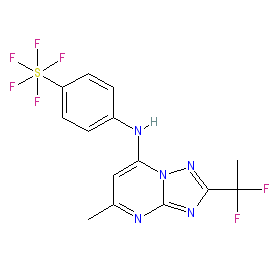GtoPdb is requesting financial support from commercial users. Please see our sustainability page for more information.
|
Compound class:
Synthetic organic
Comment: DSM265 is an optimised candidate and clinical lead from the triazolopyrimidine structural class and represents a new class of antimalarial drug [1].
The Malaria tab on this ligand page provides additional curator comments of relevance to the Guide to MALARIA PHARMACOLOGY. Ligand Activity Visualisation ChartsThese are box plot that provide a unique visualisation, summarising all the activity data for a ligand taken from ChEMBL and GtoPdb across multiple targets and species. Click on a plot to see the median, interquartile range, low and high data points. A value of zero indicates that no data are available. A separate chart is created for each target, and where possible the algorithm tries to merge ChEMBL and GtoPdb targets by matching them on name and UniProt accession, for each available species. However, please note that inconsistency in naming of targets may lead to data for the same target being reported across multiple charts. ✖ |
|
|||||||||||||||||||||||||||||||||||
| No information available. |
Summary of Clinical Use  |
| DSM265 has completed a Phase 2a clinical trial (NCT02123290) for single-dose treatment of malaria caused by P. falciparum and P. vivax infection. Results from this trial demonstrate rapid clearance of P. falciparum parasitaemia but less effective clearance kinetics for P. vivax [3]. Extended observation identified a resistance-associated mutation in PfDHODH in a number of individuals with recurrence of P. falciparum malaria, leading to the recommendation that further clinical development takes this into consideration to safeguard the therapeutic potential of DSM265. |
| Clinical Trials | |||||
| Clinical Trial ID | Title | Type | Source | Comment | References |
| NCT02123290 | DSM265 Phase IIa Investigation Treating Plasmodium Falciparum or Vivax | Phase 2 Interventional | Medicines for Malaria Venture | 3 | |
Pharmacokinetics  |
| Elimination |
| The terminal half-life for elimination is 86 to 118 hours [4]. |








